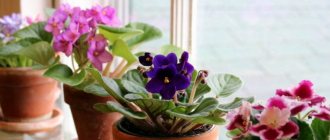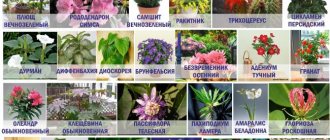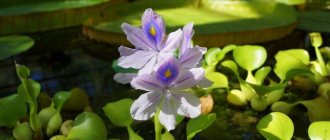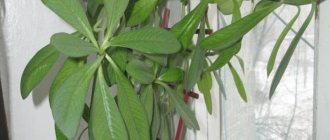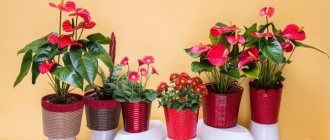Indoor flowers are our friends.
You will rarely meet a housewife who does not have green pets at home. Flowers please the eye, create positive energy, and heal. The best gift for a loved one is a flower, a symbol of love and affection.
All kinds of flowers grow in living spaces. Many of them were bought in a store, given as a gift from a friend, or planted with a cutting. Select according to original appearance or flowering. There are many colors for an apartment. But our friends are different and have certain characteristics and growing preferences.
Beneficial properties of house plants
Here are the main ones:
- Carbon dioxide accumulates in poorly ventilated rooms. Flowers absorb it and saturate the air with oxygen.
- Medicinal plant species treat cuts, burns, colds and other ailments.
- In winter, indoor air becomes dry due to the heating system, which affects the condition of the skin and well-being. Flowers help humidify the air.
- Plants absorb electromagnetic radiation that is created by household appliances and home appliances. It can affect a person’s well-being, causing insomnia and headaches.
- We are surrounded by objects that can release toxic substances. City air contains a lot of dust, exhaust gases, and heavy metals from emissions from factories and enterprises. Plants purify the air, kill microbes with the help of their phytoncides and absorb harmful impurities.
- Popular beliefs give indoor flowers the properties of bringing happiness, harmony, tranquility, etc. We included in our review some plants that, according to signs, are useful for their owners.
Chlorophytum
Chlorophytum is an unpretentious, fast-growing plant that copes with indoor air purification better than any air conditioner. Chlorophytum is a flower necessary for your home - a wonderful air purifier from dust and chemical gases, it refreshes the air in 24 hours more effectively than special devices, freeing it from all harmful impurities.
Just remember to wash off the accumulated dirt at least once a week. One plant such as chlorophytum is enough to reduce the effects of nitrogen oxides in a kitchen where gas is burning. This has been proven by experiments carried out in the USA by NASA employees. It is no coincidence that astronauts take this flower with them on their journey. Chlorophytum is merciless to harmful bacteria, moldy fungi, and toxic secretions, therefore it is deservedly considered one of the best natural orderlies. So that you can always breathe clean air, this flower must be in the kitchen, because it can cope with 80% of harmful impurities entering the air within a day.
Chlorophytum is a child of the subtropics; in nature it grows on trees, grass, and on the ground. In apartments, it is most often used as an hanging plant, that is, they decorate flower stands, shelves and walls with it. As a decorative element, the flower is very impressive: it quickly grows into lush bushes, and in the spring it produces numerous shoots with tiny flowers that look like white stars.
The most popular indoor plants for home and apartment
Indoor plants in the house lift your spirits and are pleasing to the eye. Most of them are beneficial to owners, and some are not recommended for placement in living rooms. Therefore, you need to know which indoor plants must be in the house and how to choose them correctly. You can find a complete list of indoor plants on Rastenievod.com with detailed descriptions and care tips.
Chlorophytum
Indoor chlorophytum is very useful for apartment residents. It is considered one of the most effective room air purifiers. Its beneficial properties lie in its ability to process air, purifying it of harmful substances, including formaldehyde. Formaldehyde is found in furniture, insulation, plastics, tobacco smoke, and many other places. Its synthetic component greatly harms human health. As a rule, high levels of formaldehyde are recorded in apartments. Chlorophytum is capable of clearing the air of such harmful substances within a day. Another advantage of chlorophytum is that it absorbs carbon monoxide and actively releases oxygen.
It has also been scientifically proven that adding activated carbon to a pot with this flower increases its cleansing properties several times.
Chlorophytum does not require special means or skills in caring for it (it just likes abundant watering).
Indoor geranium
Pelargonium, also known as geranium, has beneficial effects on the nervous mechanisms of the human body. It helps people cope more easily with stressful situations and nervous conditions. Geranium also has a positive effect on sleep, so even doctors recommend getting this flower for people with insomnia. Geranium helps people with headaches or blood pressure problems.
Pelargonium also has the ability to neutralize dangerous viruses and diseases, convert carbon monoxide into oxygen, and normalize the level of humidity in the air. In short, there are a lot of health benefits from this indoor flower. Geraniums are best kept in the bedroom, but do not place the plant right next to the bed.
Aloe
People often call it agave. This flower is simply a storehouse of useful properties. It is difficult to name all the diseases and injuries for which it is used, but most often it saves from colds, intestinal disorders, stomach pain, and also promotes the rapid healing of wounds and cuts.
Kalanchoe
The Kalanchoe flower was brought to us from Germany. It perfectly cleans oxygen from pathogenic bacteria, so that it will be difficult to catch a cold if such a protector is available in the house.
Homemade lemon
The lemon ornamental tree releases substances that destroy bacteria and germs in the air, thereby purifying it. Experienced plant growers, based on their experience, advise placing a lemon tree in the bedroom.
Growing decorative lemons at home requires special conditions, as well as special rules for maintenance.
Asparagus
The plant, which prolongs youth, secretes substances that increase skin elasticity. Removes heavy metals from the air. At night, it saturates the room with oxygen. Some types of asparagus are called asparagus and are used in cooking. Other types are used for compositions.
Begonia
This flower, easy to care for, carries positive energy with its bright colors. It helps to achieve harmony and develops intuition. Begonia creates a welcoming atmosphere in the apartment. This plant is worth getting for emotional people who can get upset over any little thing.
Peppermint
Mint grows well both in open ground and as a houseplant. A few mint bushes can fill a room with a pleasant aroma. In addition, its leaves can be used as a seasoning for some dishes or added to tea, so most often it is planted in small pots and placed on kitchen windowsills.
Peppermint essential oils are believed to have the ability to improve mood. Placed in the bedroom, mint will help you fall asleep easily and have a pleasant sleep. The plant also affects insects. A growing mint bush can repel flies, mosquitoes and moths.
Some housewives are sure that this plant attracts money into the house, and in the kitchen where it is cultivated there will always be an abundance of products.
Ficus
This plant copes better than all others with purifying the air from dust. Ficus also humidifies the air in the room.
The essence of the principle of action of ficus is the release of phytoncide. This substance prevents the proliferation of microorganisms. Ficus accumulates indoor dust on its leaves and thereby eliminates the spread of microbes in the air.
The method of caring for ficus is distinguished by its simplicity. It is necessary to periodically remove the layer of dust accumulated on the leaves with a damp cloth. This will allow the ficus to be saturated with oxygen and continue to accumulate all the excess dust in the room.
Anthurium and spathiphyllum
Plants symbolizing the masculine (anthurium) and feminine (spathiphyllum) principles. You need to have both plants in the house. The family will prosper. Anthurium flowers of unusual shape and bright color are used in floristry. They bloom brightly. Red and white colors are symbols of love and fidelity.
Violet
The favorite flower of most gardeners. According to signs, violets bring happiness. Not recommended for families with unmarried girls. There are more than 2000 species of these amazing flowers. Collectors are developing new varieties and adding to their collections.
Myrtle
A plant that, according to legend, gives eternal youth, beauty and family happiness. It is believed that myrtle will grow in the house when it was planted by the mistress of the house. The name is consonant with the word peace. In ancient times, myrtle was considered a powerful amulet. Women proudly planted this flower and wore the most beautiful clothes.
Crassula
This plant can be squat or tall, with a thick trunk. It is often called the money tree. Crassula has small dark green leaves that are arranged symmetrically on the branches. They look like little coins. Therefore, it is believed that the fat woman is capable of attracting material wealth into the house.
Rosemary
This type of plant is characterized by the fact that it helps with diseases such as bronchitis or asthma. Pulmonologists often advise people with problems with the respiratory system to have this plant at home. Rosemary also increases people's activity, relieves stress and helps with fatigue.
The oils released by rosemary have a positive effect on the circulatory system, and thereby increase the efficiency of the brain, improve concentration and attention.
Camellia
With such a flower in the bedroom, the passion in intimate relationships will never fade away for the spouses. Even if everything is fine sexually, the flower should be placed near the sleeping place as a talisman. Who knows? You need to choose red shades of flowering, symbolizing love; besides, this color goes well with any interior.
Orchid
An orchid is a flower that has the energy of love. The presence of this amazing flower creates an aura of well-being. Clears away negativity and brings happiness to the home. Have this beautiful flower in your home. It will delight you with its flowering and unusual appearance. Make sure that the male part of the family has little contact with the flower. Place the beauty where men are least likely to be.
Cactus
The length of a cactus’s needles is an indicator of the effectiveness of its positive effect on human health. It differs from other plants in that it is able to neutralize electromagnetic radiation by reducing air ionization. In simple words, it is able to reduce harm from a computer or TV.
Most often, the cactus is placed on the desktop near the personal computer.
Cyclamen
An indoor plant with dark matte leaves with white inclusions. Cyclamen inflorescences resemble butterflies; their shade can vary. Most often, one shade smoothly transitions into another. Flowers have strong energy. They help get rid of fears, depression, bad dreams.
Fern
Reliable protection for every home. It completely neutralizes bad energy that comes into the house from the street or from negative people, and also reduces harmful radiation from household appliances.
Azalea
Azalea pleases its owners with delicate buds that bloom even in winter. Its mesmerizing flowers come in a variety of colors - from snowy white to lilac and dark red. Against the background of windows painted with frost, they look simply amazing and create a special aura in the house. The plant sometimes blooms so profusely that even the leaves are not visible behind its flowers.
Azalea smoothes out conflicts, reduces the level of aggression, even in animals, removes nervousness, and relieves fatigue. To get into a positive mood, sit next to this flower. You will feel how it relieves tension, takes away worries and worries, makes your thoughts cleaner and calmer.
Azalea relieves eye fatigue, eliminates inflammation caused by both insomnia and long hours of work at the computer, and even, according to experts, improves vision. And the petals of the plant are used to treat stye: they are secured with a bandage on the inside of the wrists for 5-6 hours.
For people of creative professions, azalea gives inspiration, a sense of self-confidence, faith in one’s own strength, and helps to cope with anxiety in important situations. Plants with dark red flowers repel moths, house ants, tree beetles and other small pests.
Balsam
Balsam, which has been famous since ancient times for its powerful magical powers, will be no less effective in cleansing the home aura. Other names for this plant are impatiens, light, Vanka wet. The flower relieves the residents of the house from negative emotions and replaces them with a good mood, extinguishes quarrels in the bud and smooths out omissions.
Eucharis (indoor lily)
Women who want to strengthen their relationship with their husband and direct his gaze not at female strangers, but at themselves, should take a closer look at the indoor white lily. This plant will endow its owner with magical feminine charms, but only if she places the flower pot where it will be regularly illuminated by moonlight.
Zamioculcas
This home flower has similar properties and is also called the dollar tree. The plant gives its owner status and prestige, miraculously improves financial affairs, and brings monetary success and wealth.
Spathiphyllum - “female happiness”
Spathiphyllum is popularly called the flower “female happiness.” It is believed that it brings good luck to the beautiful half of humanity in their personal lives: it helps unmarried girls find their love, and helps married girls to establish harmony in the family. If you believe popular beliefs, only spouses who love and respect each other will be delighted by spathiphyllum with its unusual, sail-like flowers.
It has “feminine happiness” and other beneficial properties: it releases substances that help a person relieve stress, well moisturizes and ozonates dry air, and cleanses it of harmful toxins. Spathiphyllum does not disdain even the most menial work. It can cope not only with colonies of microorganisms, but also with vapors of ammonia, benzene, acetone and various alcohols. Spathiphyllum absorbs carbon monoxide, xylene, toluene, formaldehyde, and has no equal in the fight against chemicals and moldy fungi. You can put a flower in any room. Along with the “white sails,” it’s good to move into a new apartment that has recently been renovated: thanks to spathiphyllums, you will breathe clean air.
List of the Best Houseplants for the Bedroom
Everything in the bedroom should contribute to proper rest, including plants. Therefore, you need to approach the selection of specimens wisely. Otherwise, there is a risk of placing flowers that will cause discomfort during rest and sleep.
Best indoor plants to grow in your bedroom:
- chlorophytum;
- spathiphyllum;
- aloe;
- Kalanchoe;
- geranium;
- mother-in-law's tongue;
- myrtle tree;
- lavender;
- jasmine.
Aloe arborescens (agagave)
Aloe - special substances that this flower releases into the atmosphere, absorb harmful emissions from linoleum, remove electricity in the room and have a positive effect on the human biofield. At night, the plant produces oxygen, so the place for a pot of aloe is in the bedroom.
Since ancient times, people believed that this flower brings good luck and protects against unkind people and evil forces. Aloe does not like guests, so it is better to hide the plant from prying eyes.
It is impossible not to mention the multifaceted medicinal properties of this useful flower. Aloe is an “ambulance” at home. Its juice is used to treat runny nose, headaches, digestive tract problems, skin diseases, and washed and cut in half leaves are applied to wounds and burns. Aloe perfectly disinfects and accelerates the healing of damaged tissue. It’s also worth learning from this resident of hot deserts about perseverance and love of life.
The best flowers for the kitchen
The kitchen is not an ideal place to grow indoor plants. Due to temperature changes and high humidity, many flowers suffer and get sick.
But there are several specimens that will not only take root well when surrounded by a stove and various household appliances, but will also eliminate its negative effects and become an excellent air filter. In addition, an oasis in the kitchen will improve digestion and perfectly complement the interior.
So, when creating a mini-garden on the kitchen windowsill, you can choose from such green representatives of nature as:
- Aglaonema. This plant loves moisture and copes with air purification. It will reduce the presence of harmful substances in the kitchen space emitted by plastic, furniture, and varnish coatings. The disadvantages include slow growth and adverse effects on the eyes. Therefore, it is better to place the plant higher so that a child or animal cannot reach it.
- Scindapsus . This plant is also capable of purifying the air. Housewives loved it for its unpretentiousness, which means that it can be grown in the kitchen area. The plant is a vine that can produce shoots up to 2 meters long. It grows quickly and therefore requires frequent fertilization.
- Mother-in-law's tongue . The plant is unpretentious and has very beautiful tiger leaves. May bloom with small white flowers. It filters the air well and neutralizes harmful substances. Fits well anywhere in the kitchen. In full shade the leaf may darken. Perfectly complements the interior of any style. As for care, the plant needs constant wiping of the leaves.
Geranium (pelargonium)
Geranium (pelargonium) is an unpretentious and surprisingly useful flower. Our grandmothers used compresses from its mashed leaves to treat runny noses, otitis media, headaches, muscle pain, and ulcers on the body. Pelargonium has long been held in high esteem: ladies of the court decorated their hats with flowers, and healing balms were made from the juice of the plant. Both in Rus' and in medieval Europe, geranium was used to fight evil spirits and protect against black magic.
This beautiful plant, which blooms with pink, red and white flowers, exudes the scent of mint, rose, almond, lemon, apples and lilac, is very much appreciated today. Geranium will not only decorate your home, but will also refresh stale air, rid it of dampness and pathogenic microbes, and in summer it will repel flies. The plant is well suited for both the kitchen and the bedroom. The main thing is not to place it next to the bed.
The aroma emitted by pelargonium inflorescences has a beneficial effect on metabolic processes, lowers blood pressure, relieves nervous tension, and helps with insomnia. If you are very tired, sit next to the geranium, but not for long, otherwise you may get a headache. The plant has too powerful energy. Pelargonium strengthens character, develops a sense of humor, and promotes personal success.
SanPiN standards for temperature in an apartment in 2022
According to the text of the regulatory documentation SanPiN 1.2.3685-21 (Table 1 in Appendix 2), the internal air temperature of apartments in 2022, depending on their functional purpose, must be no less than the following indicators (Table 5.27):
- Living rooms - from 20 to 22 °C in winter and from 22 to 25 °C in summer.
- Kitchens, separate bathrooms, bathrooms – 19 – 21 oC.
- Combined bathrooms, showers - 24 - 26 oC.
- Inter-apartment corridors – 18 – 20 oC.
- Lobbies and staircases – 16 – 18 oC.
- Storerooms – 16 – 18 oC.
According to SanPiN for temperature in an apartment 1.2.3685-21, the optimal internal air temperature, which determines a comfortable living environment for people, is 20 - 25 oC.
Optimal and permissible standards for microclimate parameters in the service area (habitat zone) of residential buildings and dormitories.
| Period of the year | The name of a room | Air temperature, °C | Resulting temperature, °C | Relative humidity, % | Air speed, m/s | ||||
| optimal _ _ | permissible _ | optimal _ _ | permissible _ | optimal _ _ | permissible _ | optimal no more | permissible , no more | ||
| 1 | 2 | 3 | 4 | 5 | 6 | 7 | 8 | 9 | 10 |
| Cold | Living room | 20-22 | 18-24 | 19-20 | 17-23 | 45-30 | 60-30 | 0,15 | 0,2 |
| Living room in stationary social service organizations | 20-22 | 20-24 | 19-20 | 19-23 | 45-30 | 60-30 | 0,15 | 0,2 | |
| In areas with the coldest five-day temperature (probability 0.92) minus 31°C and below: | |||||||||
| - Living room | 21-23 | 20-24 | 20-22 | 19-23 | 45-30 | 60-30 | 0,15 | 0,2 | |
| — Living room in stationary social service organizations | 21-23 | 22-24 | 20-22 | 21-23 | 45-30 | 60-30 | 0,15 | 0,2 | |
| Kitchen | 19-21 | 18-26 | 18-20 | 17-25 | not standardized (NN) | NN | 0,15 | 0,2 | |
| Toilet | 19-21 | 18-26 | 18-20 | 17-25 | NN | NN | 0,15 | 0,2 | |
| Bathroom, combined toilet | 24-26 | 18-26 | 23-27 | 17-26 | NN | NN | 0,15 | 0,2 | |
| Facilities for recreation and study sessions | 20-22 | 18-24 | 19-21 | 17-23 | 45-30 | 60-30 | 0,15 | 0,2 | |
| Inter-apartment corridor | 18-20 | 16-22 | 17-19 | 15-21 | 45-30 | 60-30 | NN | NN | |
| Lobby, staircase | 16-18 | 14-20 | 15-17 | 13-19 | NN | NN | NN | NN | |
| Storerooms | 16-18 | 12-22 | 15-17 | 11-21 | NN | NN | NN | NN | |
| Warm | Living room | 22-25 | 20-28 | 22-24 | 18-27 | 60-30 | 65-30 | 0,2 | 0,3 |
Common myrtle
Myrtle (myrtle tree) is not only a very beautiful plant, but also an extremely useful plant for humans. It is considered a symbol of family happiness and the guardian of the hearth. In Ancient Greece, brave warriors were honored with graceful branches of myrtle, wreaths were woven from them for brides, and cooks used the dried leaves of the plant for cooking.
During flowering, myrtle is covered with small, star-like flowers. But it pleases its owners not only with its attractive appearance, but also with its multifaceted healing properties. The plant destroys about 40% of pathogenic microorganisms present in the air, thereby reducing the risk of colds. The smell of myrtle cleanses the mind, has an enlightening effect, helps a person restore harmony with the outside world, and brings peace and happiness to the home.
Myrtle oil is very popular among perfumers. And herbalists consider myrtle to be a universal plant. It is used to treat allergies, blood and eye diseases, intestinal and bladder diseases, as an antitumor and anti-inflammatory agent. Myrtle grows well and can be used for decorative purposes to create bonsai. Myrtle is also suitable for decorating a winter garden, and due to its shade tolerance, it is suitable for interior landscaping.
Common mistakes
When a favorite plant begins to behave strangely, the leaves droop, the plant stops blooming - this causes concern.
First of all, the lack of moisture comes to mind, and owners of indoor flowers begin to water it more often. If this does not change the situation in any way, you should think about whether it’s time to transplant your pet into a larger pot.
The plant grows and develops, the root system takes up more and more space in the pots. Accordingly, the plant receives less and less nutrition.
Sometimes the small-leaved ficus begins to shed its leaves for no reason.
It is worth considering whether this behavior is so unreasonable. Ficus is a very capricious plant. It reacts to any irritants - to a draft, to insufficient or excessive lighting, to too frequent or, conversely, infrequent watering.
With watering, everything is simple - you should water no more often than the soil is completely dry.
As for the rest, the ficus needs to be moved from place to place until it is satisfied with its place. Even if, in the owner’s opinion, this place is completely inappropriate.
What to do if a flower from the unwanted list is already at home
Let's assume that a houseplant, whose presence in the house is known to be dangerous, was received as a gift. Or after reading about some flower from the “dangerous” list, the latter is found in the house.
This is not at all a reason to get rid of the handsome man. After all, it is not at all necessary that this plant will cause harm. If there is a possibility that children or pets will get to the pot, you need to come up with places - hanging shelves, stands - where access to the flower will be limited.
When caring for the plant, the owner should simply use gloves and, if absolutely necessary, a protective mask.
It happens that poisonous plants still have a negative impact on human health, with severe allergic reactions to the components of the flower. In this case, you need to try to attach the plant to friends, neighbors, or take it to work, placing it in a large hall.
Answers to frequently asked questions
Is it true that cacti should protect against electromagnetic radiation?
There is some truth in this. Indeed, cacti grow well near computers on desktops. The plant ionizes the air around it well. The spines, acting as antennas, actually absorb some of the radiation. At the same time, cacti feel great.
Does Tradescantia really show troubled places in the house?
Tradescantia is just as capricious in its placement in the house as ficus. If you don’t “like” the place, Tradescantia will begin to turn yellow and shed its leaves. Considering these places unfavorable for humans is groundless. And for the plant you will have to look for another place.
Cactus
Cactus - this exotic plant was eaten in ancient times, medicines were made from it, and the needles were used as toothpicks.
The cactus is a protective plant. It is good to place it on windowsills. Place one cactus on a north window, another on a west window, and so on. This arrangement will help protect your home from thieves. You should not place cacti in the bedroom where spouses sleep, this reduces sexual fervor.
Experts advise placing cacti in the office. They absorb positive cations from the air, an excess of which leads to headaches.
The cactus, in addition to being unpretentious, can please its owners with a wide variety of shapes and delicate, beautiful flowers. If you properly care for a cactus, it will make the energy in the house more harmonious and balanced, clear the space of negative energy, and help improve the financial situation of its inhabitants. According to Feng Shui, this flower symbolizes accumulation, as it can use moisture very economically. The main thing is to water the plant in a timely manner so that it does not turn from a prickly helper into an energy vampire.
You should not place a cactus in the bedroom where spouses sleep: it can provoke “prickly” relationships, quarrels and disagreements, and also reduce sexual fervor. But in the office his presence is very appropriate.
Ficus
Ficus - this beautiful flower with fleshy, glossy leaves has always been one of the most desirable inhabitants in the house. In addition to saturating the air with oxygen, it also cleanses it, but not only from toxins. Like a vacuum cleaner, ficus absorbs the dust of our worries and doubts. The plant also releases substances that have a positive effect on sleep. Its presence in the bedroom will help you fall asleep peacefully and wake up cheerfully. In addition, the flower improves mutual understanding between loving hearts, helps spouses achieve harmony in relationships, become more patient and attentive to each other.
Ficus has a very positive effect on the character of the people living in the house. It calms, relieves anxiety and aggression, instills optimism, eradicates the need to arouse pity from others, develops enthusiasm, teaches you how to rationally distribute your time, and helps you concentrate. His presence is very welcome in rooms where work is in full swing. Ficus also helps to overcome the fear of public speaking. They even advise you to rehearse your speech before the flower.
It is believed that all types of ficus have a beneficial effect on the atmosphere of the home. They filter indoor air well, absorbing harmful substances such as benzene, phenol and trichlorethylene. The plant binds them and processes them into amino acids and sugars. Ayurvedic practice emphasizes the benefits of ficus as a plant that harmonizes home energy. It is believed that ficus clears the surrounding space of anger, anxiety and worries, which contributes to a positive solution to difficult life situations. There is a sign that if there are no children in a family for a long time, it is necessary to plant a ficus.
It is read that all types of ficus have a beneficial effect on the atmosphere of the house. They filter indoor air well, absorbing harmful substances such as benzene, phenol and trichlorethylene. The plant binds them and processes them into amino acids and sugars. Ayurvedic practice emphasizes the benefits of ficus as a plant that harmonizes home energy. It is believed that ficus clears the surrounding space of anger, anxiety and worries, which contributes to a positive solution to difficult life situations. There is a sign that if there are no children in a family for a long time, it is necessary to plant a ficus. However, this in no way cancels visiting a doctor.

